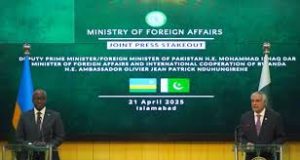Italy: Politicians demand intervention as drought grips the south

Rome: Water reserves are running dry in parts of Italy, leading some politicians to demand urgent action on the climate emergency.
“The climate crisis is not ideological, it is a dramatic reality in Sicily,” Angelo Bonelli, spokesperson for the Europa Verde (Green Europe) political party, said while rallying outside government headquarters in Rome on Thursday.
“Farmers are uprooting vineyards, citrus groves, they are slaughtering animals because there is no water. This is a disastrous situation.”
Condemning Prime Minister Giorgia Meloni’s silence on the issue, he said the government is “leaving an entire region on its knees.”
A navy tanker was called in to rescue Sicily’s parched southwest coast on Friday, shipping in 1,200 cubic metres of water.
The island, the largest in the Mediterranean, has been battling its worst drought in 20 years, which forced local officials to declare a state of emergency back in February.
It’s not the only part of Italy that’s suffering. On Friday, the southwest region of Calabria declared a drought emergency in the face of serious drinking water shortages.
Less than three weeks of water supply remain for agriculture in the centre-south of the country, according to a report by the ANBI Observatory on Water Resources. It says water rationing is expanding – in some areas, even for drinking water.
Abruzzo, Basilicata, Campania, Lazio, Puglia and Sardinia are among the other regions struggling with drought.
This is in stark contrast to northern Italy, which has faced storms, floods and landslides in recent weeks.
“The current picture of Italy’s water supply is that of a north overabundant with water and a centre-south parched by drought, where important economic assets such as agriculture and tourism are at risk,” says Massimo Gargano, general director of ANBI.
“We must be aware, at every level, that the climate has changed and that a new model for the territory is needed, where resilience can only be accompanied by maintenance, infrastructure and innovation.”
Joining Bonelli outside Palazzo Chigi on Thursday, MPs from the Greens and Left Alliance (AVS) held signs reading “The climate crisis is a dramatic reality, the government has no strategy”.
“It’s not just a gigantic environmental problem, it’s also a gigantic social problem,” said Italian Left politician Nicola Fratoianni. “The climate crisis affects inflation, it affects the purchasing power of the already too low wages of Italian women,” he continued.
The speakers highlighted what they see as the government’s misplaced priorities, including assigning €3 billion from Italy’s National Climate Fund to the “laborious and unclear” Mattei Plan, which aims to boost ties with and development in Africa.
Its key goals are to make Italy an energy hub to transport natural gas from the continent to the rest of Europe, curbing irregular immigration in the process. It also includes plans to strengthen energy efficiency and promote the use of renewable energy.
They also noted the “contradiction” of ploughing resources into the Strait of Messina Bridge, which will link Sicily to mainland Italy, while the island suffers.
Earlier this month Sicily received €92 million of the projected €1.6bn for a regional water plan aimed at strengthening water infrastructure and preventing drought.
Among the plans are leaky pipeline replacements and floodgate maintenance at dams used for irrigation.
While a severe lack of rain and excessive heat have sparked the latest water crisis, it is made worse by the island’s crumbling infrastructure, which is old and poorly maintained.
For example, the reservoir at the Trinità dam in Castelvetrano has never been safety tested and has been waiting for structural interventions for years to increase the water flow. This has led to precious water supplies being released into the sea from the dam when waters rise. Thousands of hectares of land depend on it for irrigation.
In the meantime, it has been left to local municipalities to pick up the pieces with restrictions on the use of drinking water for irrigation and swimming pools, along with reducing flow rates during the nighttime.





